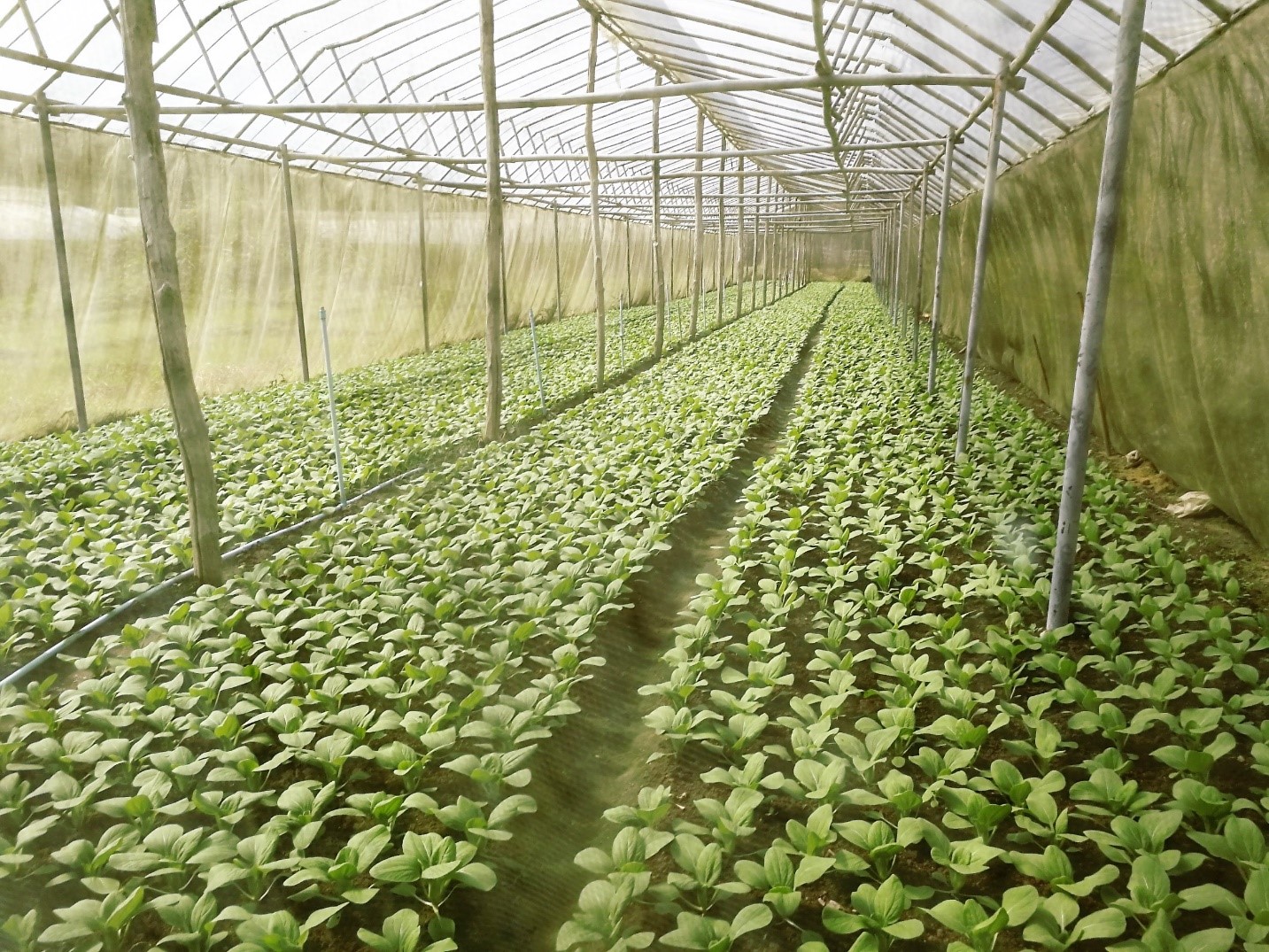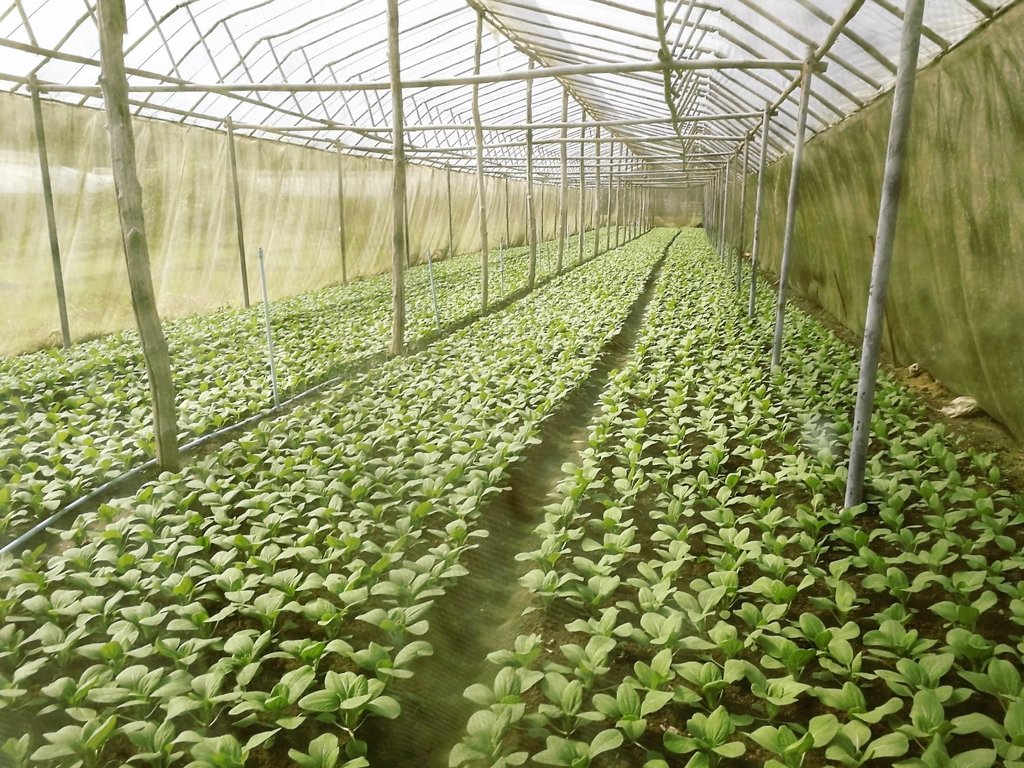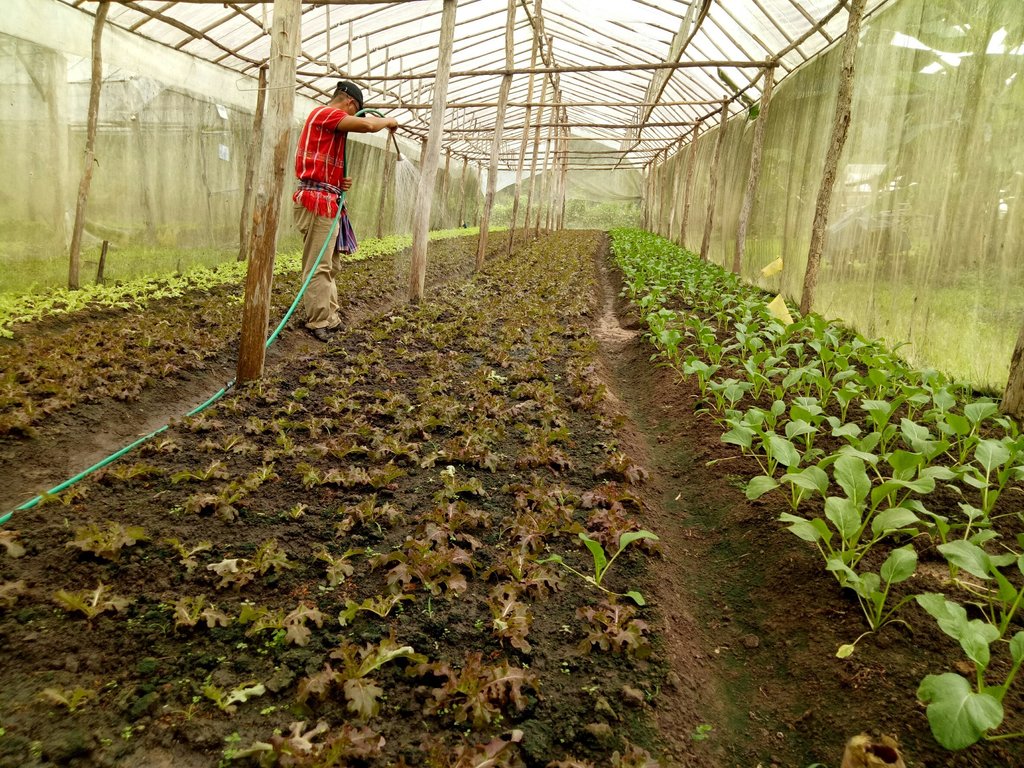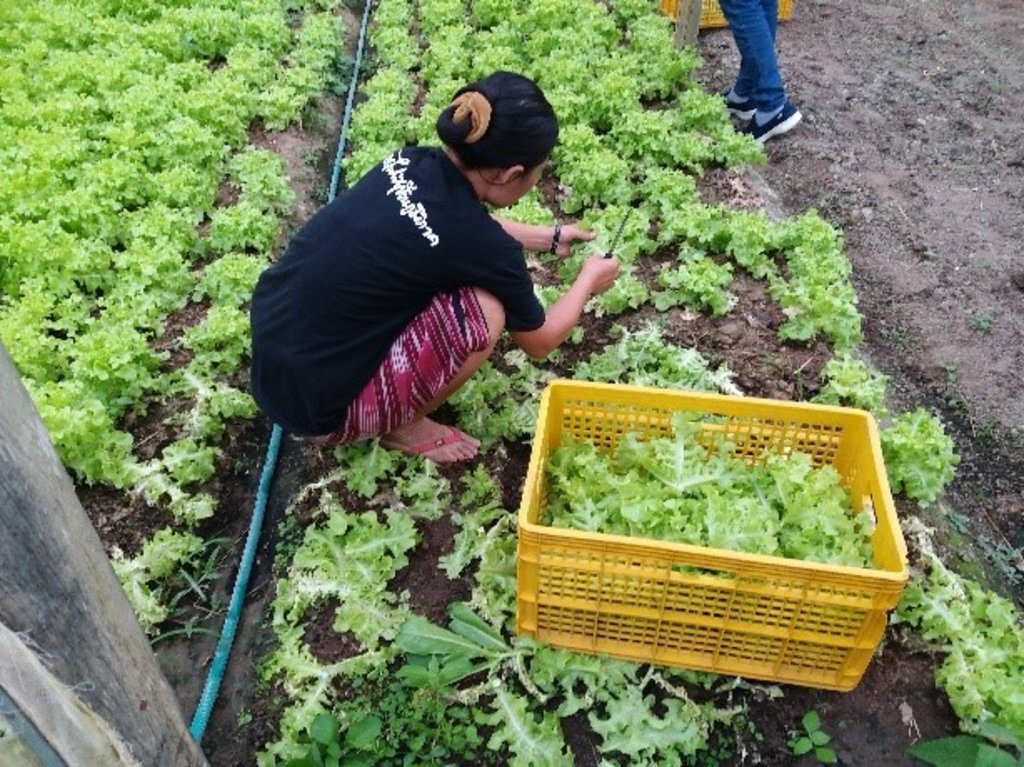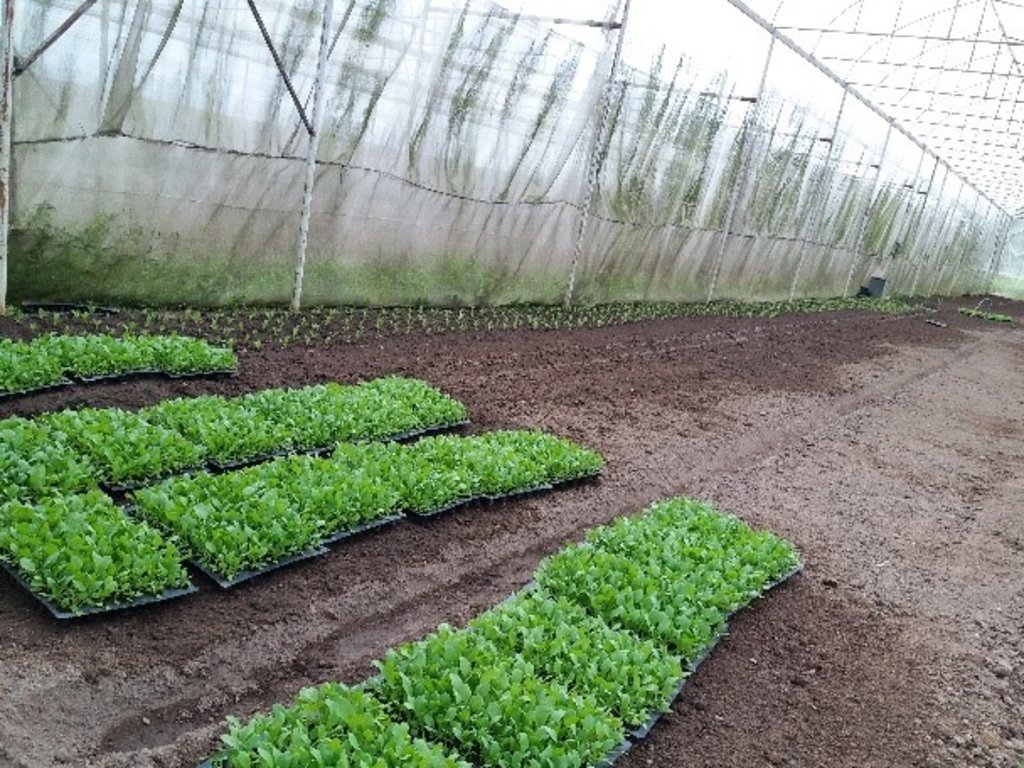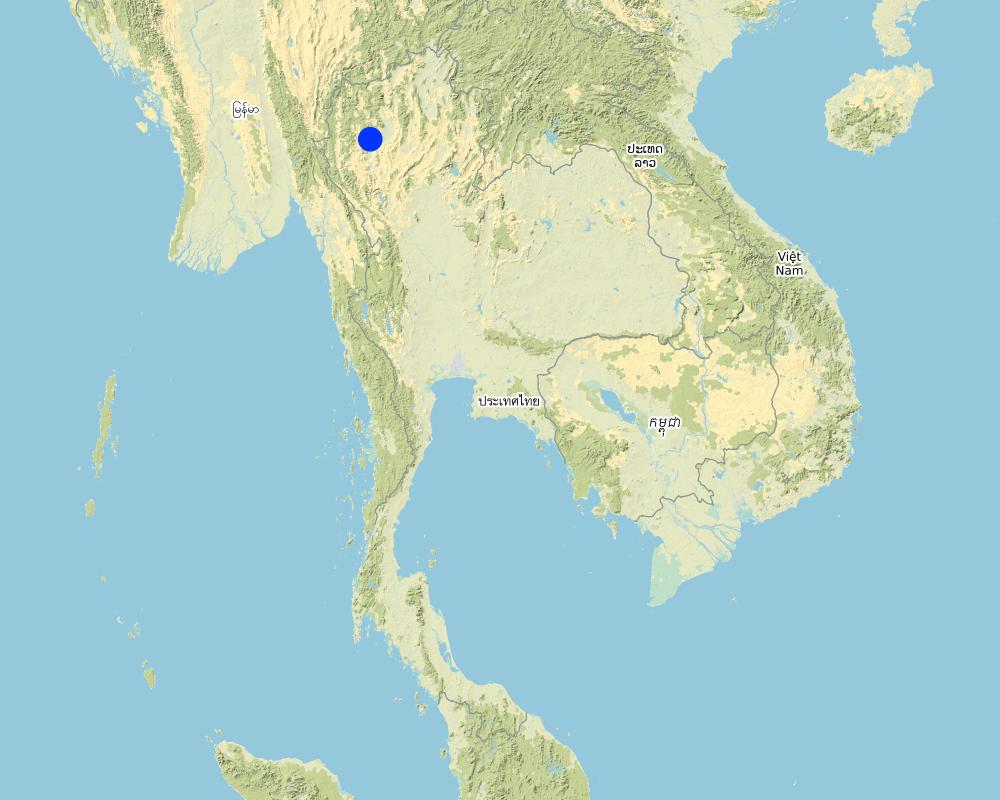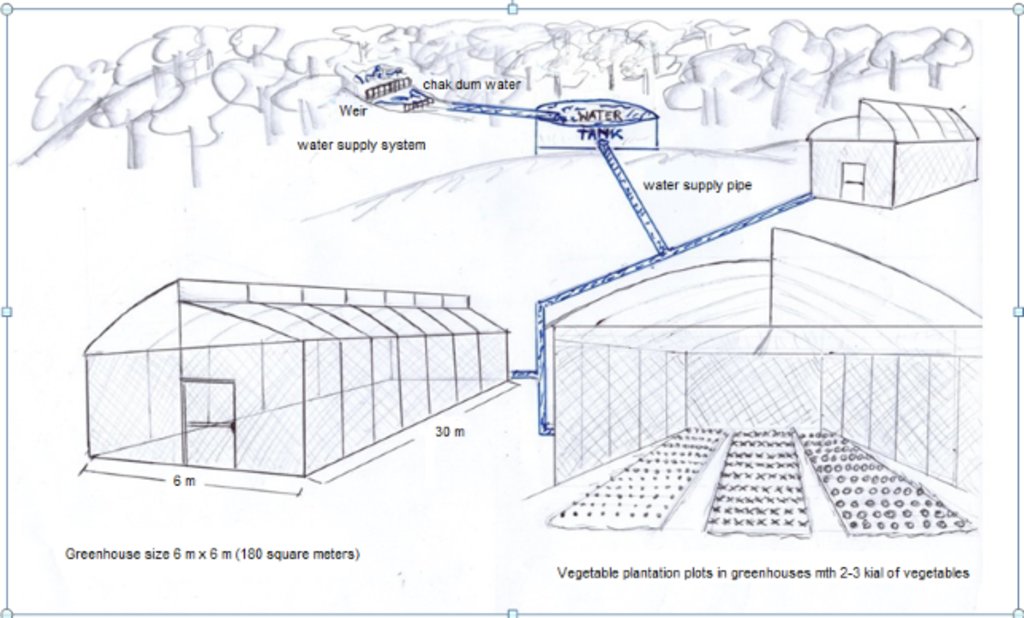Integrated Soil Management for Organic Vegetables on the Highland Watershed in the Northern Region [Tailândia]
- Criação:
- Atualização:
- Compilador/a: Pitayakon Limtong
- Editor: –
- Revisores: Rima Mekdaschi Studer, William Critchley
Organic vegetables in the Royal Project
technologies_4283 - Tailândia
Veja as seções
Expandir tudo Recolher tudo1. Informação geral
1.2 Detalhes do contato das pessoas capacitadas e instituições envolvidas na avaliação e documentação da tecnologia
Pessoa(s) capacitada(s)
co-compiler:
Wattanaprapat Kamalapa
Land Development Department
Tailândia
usuário de terra:
Phojanabandit Watcharin
Headman of village
Tailândia
local extension officer:
Kerephuwadon Boontre
Inthanon Royal Agricultural Station, the Royal Project
Tailândia
local LDD officer:
Intha Charun
Royal Project Land Development Center, Land Development Office Region 6, Land Development Department.
Tailândia
Nome da(s) instituição(ões) que facilitou(ram) a documentação/ avaliação da Tecnologia (se relevante)
Land Development Department LDD (Land Development Department LDD) - Tailândia1.3 Condições em relação ao uso da informação documentada através de WOCAT
O compilador e a(s) pessoa(s) capacitada(s) aceitam as condições relativas ao uso de dados documentados através do WOCAT:
Sim
1.4 Declaração de sustentabilidade da tecnologia descrita
A tecnologia descrita aqui é problemática em relação a degradação da terra de forma que não pode ser declarada uma tecnologia de gestão sustentável de terra?
Não
Comentários:
Organic vegetable production is a technology that prevents and restores land degradation due to soil management emphasized in using organic and natural materials to improve soil fertility and productivity, especially in terms of soil organic matter.
2. Descrição da tecnologia de GST
2.1 Descrição curta da tecnologia
Definição da tecnologia:
Organic vegetable cultivation on the highland area of the northern region of Thailand has been encouraged by local officers in order to produce safe food on degraded land through building up soil fertility and soil organic matter.
2.2 Descrição detalhada da tecnologia
Descrição:
This case study is of organic vegetable cultivation at Ban Muang Ang Village which is located in Ban Luang Sub-district, Chom Thong District, Chiang Mai Province, covering approx. 25,881 Rai (6.25 rai = 1 ha; 625 rai = 1 sq km). The topography is a complex mountainous area within the Doi Inthanon National Park, at an elevation of 600-800 m asl. The climate is quite cool and humid with average temperature throughout the year being 20⁰C. The average annual rainfall is 2,000-2,100 mm. Most of the population belong to the Pakhayo hilltribe, living in 219 households, with total population of 588 persons (308 males, 280 females). The main purpose of promoting growing organic vegetables in greenhouses is to change their way of life from forest encroachment/ shifting cultivation in the upper watershed, to improving the ecosystem services and environment with better health and higher incomes for villagers.
Since 2002, the government and the Royal Project Foundation have had a policy to change land use to organic farming. At the early stage, yields of organic vegetables were not good. In the year 2010, the Inthanon Royal Agricultural Station brought a number of these land users to visit the Mae Tho Royal Project Development Center in Bo Sali Sub-district, Hot District, Chiang Mai Province. They obtained knowledge about organic cultivation in simple greenhouses made from bamboo poles, covered with plastic sheets and nylon nets. Local officers of the Inthanon Royal Agricultural Station supported with education, offered suggestions and recommended practices, as well as finding markets to sell the organic products; that became the model. It took only 25-30 days for a crop, and they could harvest about 200 kg of vegetables per greenhouse. They could produce 11 crops of vegetables in one year, which means that they could earn 10 times more income than before. At present, Muang Ang Village there are 153 members operating in 270 greenhouses which is the largest organic vegetable production area in the Inthanon Royal Project.
The production of organic vegetables in this area is outstanding. This network has received certification from the Department of Agriculture (DOA) and the Office of Organic Agriculture Certification Thailand (ACT Organic). Farmers or farming enterprises certified by this system are entitled to apply the logos and certification card of ACT Organic and IFOAM Accredited brand on their products. Moreover, the Agri-Food & Veterinary Authority of Singapore (AVA) has approved the production processes. Every production step has been approved through the standard regulation of each agency with tracking to the source of production inputs such as fertilizers, disease, weed and pest control measures, cultivation practices, etc. Now they have nine types of vegetables that constitute the main production: Choy, Baby Emperor, Cos Salad, Green Oak, Red Oak, Fille Iceberg, String Bean, Kale Hong Kong and Baby Carrot.
2.3 Fotos da tecnologia
Observações gerais sobre as fotos:
The simple nursery is 6 meters wide, 30 meters long, and 5 meters high. Organic vegetable seed is supported from the Royal Project with ready to planting into the plot.
2.4 Vídeos da tecnologia
Data:
13/09/2018
Localização:
Moo 9, Ban Mung Aung Village, Ban Luang Sub-district, Chom Thong District, Chiang Mai Province
Nome do cinegrafista:
Ms. Kamalapa Wattanaprapat
2.5 País/região/locais onde a tecnologia foi aplicada e que estão cobertos nesta avaliação
País:
Tailândia
Região/Estado/Província:
Ban Luang Sub-district, Chom Thong District, Chiang Mai Province
Especificação adicional de localização:
Inthanon Royal Agricultural Station
Especifique a difusão da tecnologia:
- Aplicado em pontos específicos/concentrado numa pequena área
Comentários:
This activity is the integrated implementation project of the Royal Project in collaboration with other government agencies.
Map
×2.6 Data da implementação
Indique o ano de implementação:
2002
Caso o ano exato seja desconhecido, indique a data aproximada:
- 10-50 anos atrás
2.7 Introdução da tecnologia
Especifique como a tecnologia foi introduzida:
- através de projetos/intervenções externas
Comentários (tipos de projeto, etc.):
All knowledge and technology is supported by the Royal Project collaboration with Land Development Department and other government and private agencies.
3. Classificação da tecnologia de GST
3.1 Principal/principais finalidade(s) da tecnologia
- Preserva ecossistema
- Preservar/melhorar a biodiversidade
- Criar impacto econômico benéfico
3.2 Tipo(s) atualizado(s) de uso da terra onde a tecnologia foi aplicada

Terra de cultivo
- Cultura anual
Especifique:
Vegetables: Cantonese, Baby Emperor, CosSalad, Oak leaf Green, Oak leaf Red, Guest Bean, Filler Iceberg, Kale Hong Kong and Baby Carrot.

Vias navegáveis, corpo d'água, zonas úmidas
Principais produtos/serviços:
Irrigation water from a storage tank at the upper part, through PVC pipes to the area cultivated to the organic vegetables.
Comentários:
In the past, villagers had encroached on forest areas and deforestation in highland for shifting cultivation, and also expand cultivation area into steep slope. Resulting in the destruction of forest areas and accelerated soil degradation. Villagers have low incomes: not enough to survive. But due to the grace of His Majesty King Bhumibol Adulyadej, King Rama 9 set up the Royal Project to distribute knowledge and education to all farmers in this area, and assist them to have better occupation and living standards.
3.3 O uso do solo mudou devido à implementação da Tecnologia?
Comentários:
The Royal Project has promoted the production of organic vegetables. Farmers therefore have changed from shifting cultivation to organic agriculture with sustainable soil management. As well as returning from forest areas and conserving soil, water and forest resources, maintaining ecological balance, this all makes villagers lives better. According to the cultivation schedule provided by the Royal Project, this area can cultivated throughout the year due to the development of irrigation systems from the storage tank in the upper part and supply to each plot of this targeted area.
3.4 Abastecimento de água
Outros (p. ex. pós-inundação):
- water from watershed area
Comentários:
Water resources are obtained from watercourses in the watershed, with a small dam which collects water in a reservoir. A PVC pipe is connected from the reservoir to individual plots and this irrigation system allows allocation to every farmer by the water management group.
3.5 Grupo de GST ao qual pertence a tecnologia
- sistema rotativo (rotação de culturas, pousios, cultivo itinerante)
- Gestão integrada de pragas e doenças (inclusive agricultura orgânica)
- Gestão de irrigação (inclusive abastecimento de água, drenagem)
3.6 Medidas de GST contendo a tecnologia

Medidas agronômicas
- A2: Matéria orgânica/fertilidade do solo

Medidas de gestão
- M2: Mudança de gestão/nível de intensidade
Comentários:
-
3.7 Principais tipos de degradação da terra abordados pela tecnologia

Erosão do solo pela água
- Wt: Perda do solo superficial/erosão de superfície

Deteriorização química do solo
- Cp: poluição do solo

Degradação biológica
- Bl: perda da vida do solo
- Bp: aumento de pragas/doenças, perda de predadores
Comentários:
Organic vegetable production in greenhouses can solve the problem of soil erosion with utilization of compost, animal and green manure to increase fertility and organic matter.
3.8 Redução, prevenção ou recuperação da degradação do solo
Especifique o objetivo da tecnologia em relação a degradação da terra:
- Prevenir degradação do solo
- Reduzir a degradação do solo
Comentários:
This organic vegetable production on very steep land can prevent and reduce soil erosion. Moreover, organic material and fertilizers can restore and improve soil fertility and productivity.
4. Especificações técnicas, implementação de atividades, entradas e custos
4.1 Desenho técnico da tecnologia
Especificações técnicas (relacionada ao desenho técnico):
Operating procedures
1. Establishment of networks: All land users set up networks of organic vegetable producers and register the members properly; all members must act strictly according to the regulations.
2. Integrated cooperation: The Inthanon Royal Agricultural Station and the Inthanon Highland Agricultural Extension Center organize training on organic farming at least once a year, including study trip/s to visit other successful organic farmers.
3. Selection of the area: Leaders and members select the area for members, each member occupying not more than three greenhouses, 6m wide, 30m long and 3-5m high (180 sq m).
4. Production planning: land users discuss with the staff of the Inthanon Royal Agricultural Station, and plan the production schedule and types of vegetables to meet the market demand.
5. Procurement of production inputs: Both of local officers with inspectors and farmers can buy production inputs by themselves. All materials must be organic and are from reliable sources. Farmers must be very careful in this matter.
6. Organic vegetables cultivation: All land users must strictly comply with the schedule of cultivation, practices in soil improvement, control of pests and diseases, plus recording every step of their activities.
7. Production monitoring: Staffs of the Inthanon Royal Agricultural Station and Department of Agricultural Extension (DOAE) monitor and observe land users’ practices in using soil improvement methods and using bioproducts for controlling insects, predators, parasites and diseases. Department of Agriculture (DOA) and the Organic Agriculture Certification Thailand (ACT Organic) monitor the production process.
8. Harvesting of Products: All land users must harvest according to the harvesting schedule and the preservation methods. DOA and ACT Organic serve as certification agencies by analyzing the contamination of substances in the products.
9. Screening and packing: All land users must clean their products with non-contaminated equipment, and also screen the quality and specified size/s of products for delivery to the Inthanon Royal Agricultural Station.
Autor:
Ms.Kamalapa Watanaprapat
Data:
25/10/2018
4.2 Informação geral em relação ao cálculo de entradas e custos
Especifique como custos e entradas foram calculados:
- por área de tecnologia
Indique o tamanho e a unidade de área:
70 rai
Se utilizar uma unidade de área local, indicar fator de conversão para um hectare (por exemplo, 1 ha = 2,47 acres): 1 ha =:
1 ha = 6.25 rai
Outro/moeda nacional (especifique):
Baht (THB)
Se for relevante, indique a taxa de câmbio do USD para moeda local (por exemplo, 1 USD = 79,9 Real): 1 USD =:
32,0
Indique a média salarial da mão-de-obra contratada por dia:
300
4.3 Atividades de implantação
| Atividade | Periodicidade (estação do ano) | |
|---|---|---|
| 1. | Establish organic vegetables group | The first year of cultivation |
| 2. | Site selection | Before cultivation |
| 3. | Construct greenhouse or nursery | Before cultivation |
| 4. | Production work plan | Before cultivation |
| 5. | Procurement of production factors | Before cultivation |
| 6. | Soil preparation and improvement | During soil preparation |
| 7. | Vegetables seedling preparation | During soil preparation |
| 8. | Plantation | During vegetables planting |
| 9. | Disease and pest control | During vegetables planting |
| 10. | Vegetable harvesting | During harvesting |
| 11. | Screening and packing | After harvesting |
| 12. | Technology maintenance | After harvesting |
Comentários:
-
4.4 Custos e entradas necessárias para a implantação
| Especifique a entrada | Unidade | Quantidade | Custos por unidade | Custos totais por entrada | % dos custos arcados pelos usuários da terra | |
|---|---|---|---|---|---|---|
| Mão-de-obra | Construct greenhouse | man | 10,0 | 300,0 | 3000,0 | 100,0 |
| Mão-de-obra | During cultivation | man | 6,0 | 300,0 | 1800,0 | 100,0 |
| Mão-de-obra | During maintenance | man | 45,0 | 300,0 | 13500,0 | 100,0 |
| Mão-de-obra | During harvesting | man | 10,0 | 300,0 | 3000,0 | 100,0 |
| Equipamento | Rubber pipe | piece | 1,0 | 1000,0 | 1000,0 | 100,0 |
| Equipamento | Tractor for soil preparation | Rai | 1,0 | 300,0 | 300,0 | 100,0 |
| Material vegetal | Vegetables seed | site | 1,0 | 700,0 | 700,0 | 100,0 |
| Fertilizantes e biocidas | Animal manure (cow manure) | bag | 20,0 | 30,0 | 600,0 | 100,0 |
| Fertilizantes e biocidas | BT bio-product | litre | 100,0 | |||
| Fertilizantes e biocidas | Predators and parasites | - | ||||
| Fertilizantes e biocidas | Insect glue trap | liter | 0,5 | 290,0 | 145,0 | 100,0 |
| Fertilizantes e biocidas | Yellow plastic plate | piece | 60,0 | 5,0 | 300,0 | 100,0 |
| Fertilizantes e biocidas | Yellow plastic bag | litre | 0,5 | 120,0 | 60,0 | 100,0 |
| Material de construção | Wood frame / mesh net / plastic cloth | site | 1,0 | 14700,0 | 14700,0 | 40,0 |
| Material de construção | PVC pipe | piece | 40,0 | 40,0 | 1600,0 | 100,0 |
| Custos totais para a implantação da tecnologia | 40705,0 | |||||
| Custos totais para o estabelecimento da Tecnologia em USD | 1272,03 | |||||
Se o usuário da terra arca com menos que 100% dos custos, indique quem cobre os custos remanescentes:
Construction greenhouse cost, land users support 40%, and Organic Vegetable Production Fund support 60% of this cost.
Comentários:
Labor cost in greenhouse construction, greenhouse materials, which land users would only pay for the first year, but they do not pay for the second year and do not much towards repair cost.
4.5 Atividades recorrentes/manutenção
| Atividade | Periodicidade/frequência | |
|---|---|---|
| 1. | Changing the plastic sheet of the roof of greenhouse | 3,000 baht per greenhouse every 3 years |
| 2. | Washing the plastic sheet of the greenhouse roof | Once a year |
Comentários:
-
4.6 Custos e entradas necessárias pata a manutenção/atividades recorrentes (por ano)
| Especifique a entrada | Unidade | Quantidade | Custos por unidade | Custos totais por entrada | % dos custos arcados pelos usuários da terra | |
|---|---|---|---|---|---|---|
| Mão-de-obra | Changing plastic sheets | man | 3,0 | 300,0 | 900,0 | 100,0 |
| Mão-de-obra | Wash plastic sheets | man | 3,0 | 300,0 | 900,0 | 100,0 |
| Material de construção | Plastic sheet (change every 3 years) | roll | 1,0 | 3700,0 | 3700,0 | 100,0 |
| Custos totais para a manutenção da tecnologia | 5500,0 | |||||
| Custos totais de manutenção da Tecnologia em USD | 171,88 | |||||
Se o usuário da terra arca com menos que 100% dos custos, indique quem cobre os custos remanescentes:
Land users purchase 100%
Comentários:
Land users purchase 100%
4.7 Fatores mais importantes que afetam os custos
Descreva os fatores mais determinantes que afetam os custos:
The most important factor that affects other costs is seed. Manure must be purchased from standard organic source. The Royal Project provides standard seed, and animal manure must be purchased from other provinces that require natural cultivation farming. The source of the materials used can be traced back to the original provider. Labor factors are not impacted because they can help each other, and land users work together in each greenhouse.
5. Ambiente natural e humano
5.1 Clima
Precipitação pluviométrica anual
- <250 mm
- 251-500 mm
- 501-750 mm
- 751-1.000 mm
- 1.001-1.500 mm
- 1.501-2.000 mm
- 2.001-3.000 mm
- 3.001-4.000 mm
- > 4.000 mm
Especifique a média pluviométrica anual em mm (se conhecida):
1500,00
Especificações/comentários sobre a pluviosidade:
Rainy season is from June - October
Indique o nome da estação meteorológica de referência considerada:
Inthanon Royal Project Meteorological Station
Zona agroclimática
- Subúmido
-
5.2 Topografia
Declividade média:
- Plano (0-2%)
- Suave ondulado (3-5%)
- Ondulado (6-10%)
- Moderadamente ondulado (11-15%)
- Forte ondulado (16-30%)
- Montanhoso (31-60%)
- Escarpado (>60%)
Formas de relevo:
- Planalto/planície
- Cumes
- Encosta de serra
- Encosta de morro
- Sopés
- Fundos de vale
Zona de altitude:
- 0-100 m s.n.m.
- 101-500 m s.n.m.
- 501-1.000 m s.n.m.
- 1.001-1.500 m s.n.m.
- 1.501-2.000 m s.n.m.
- 2.001-2.500 m s.n.m.
- 2.501-3.000 m s.n.m.
- 3.001-4.000 m s.n.m.
- > 4.000 m s.n.m.
Indique se a tecnologia é aplicada especificamente em:
- Posições convexas
Comentários e outras especificações sobre a topografia:
Most of the area is mountainous slope complex, with a steep slope and attitude is 1,200-1,400 meters above sea level. The forest condition is good, and some areas of the Doi Inthanon is national park and some is in national forest reserve.
5.3 Solos
Profundidade do solo em média:
- Muito raso (0-20 cm)
- Raso (21-50 cm)
- Moderadamente profundo (51-80 cm)
- Profundo (81-120 cm)
- Muito profundo (>120 cm)
Textura do solo (solo superficial):
- Médio (limoso, siltoso)
Textura do solo (>20 cm abaixo da superfície):
- Grosso/fino (arenoso)
Matéria orgânica do solo superficial:
- Médio (1-3%)
Caso disponível anexe a descrição completa do solo ou especifique as informações disponíveis, p. ex. tipo de solo, PH/acidez do solo, nitrogênio, capacidade de troca catiônica, salinidade, etc.
Soil pH is 5.5-6.0
5.4 Disponibilidade e qualidade de água
Lençol freático:
> 50 m
Disponibilidade de água de superfície:
Bom
Qualidade da água (não tratada):
apenas para uso agrícola (irrigação)
A salinidade da água é um problema?
Não
Ocorre inundação da área?
Não
Comentários e outras especificações sobre a qualidade e a quantidade da água:
Water flows from the watershed area of the upper forest, and not flow through the conventional agricultural area.
5.5 Biodiversidade
Diversidade de espécies:
- Médio
Diversidade de habitat:
- Médio
Comentários e outras especificações sobre biodiversidade:
Biodiversity in this area has a variety of insects. There are both pests and predators.
5.6 Características dos usuários da terra que utilizam a tecnologia
Sedentário ou nômade:
- Sedentário
Orientação de mercado do sistema de produção:
- misto (subsistência/comercial)
Rendimento não agrícola:
- 10-50% de toda renda
Nível relativo de riqueza:
- Média
Indivíduos ou grupos:
- Grupos/comunidade
Nível de mecanização:
- Trabalho manual
Gênero:
- Mulheres
- Homens
Idade dos usuários da terra:
- Jovens
- meia-idade
- idosos
Indique outras características relevantes dos usuários da terra:
Land users can cultivate organic vegetables and earning more income, where young generation in the village become interested and help their families to cultivate organic vegetables. Moreover these young generation who have graduated from university like to become farmers and do not leave to other occupations.
5.7 Área média de terrenos utilizados pelos usuários de terrenos que aplicam a Tecnologia
- < 0,5 ha
- 0,5-1 ha
- 1-2 ha
- 2-5 ha
- 5-15 ha
- 15-50 ha
- 50-100 ha
- 100-500 ha
- 500-1.000 ha
- 1.000-10.000 ha
- > 10.000 ha
É considerado pequena, média ou grande escala (referente ao contexto local)?
- Média escala
Comentários:
Most land users have an average land of 20 rai, consisting of 3-5 rai for rice fields, and 10-15 rai of rotation cultivation. They do not have right in landownership because all of these land are in the reserved forest area and national park. But they have right in utilize their land under the Royal Project.
5.8 Propriedade de terra, direitos de uso da terra e de uso da água
Propriedade da terra:
- Indivíduo, não intitulado
Direitos do uso da terra:
- Comunitário (organizado)
Direitos do uso da água:
- Comunitário (organizado)
Especifique:
-
Comentários:
Land users in this area are Lawa hill tribe who migrated from different places to settle here. The main occupation is agriculture under crop rotation, some harvesting of forest products, and some animals. They have not right in landownership but they have right to utilize their land and water for agricultural activities under the Royal Project.
5.9 Acesso a serviços e infraestrutura
Saúde:
- Pobre
- Moderado
- Bom
Educação:
- Pobre
- Moderado
- Bom
Assistência técnica:
- Pobre
- Moderado
- Bom
Emprego (p. ex. não agrícola):
- Pobre
- Moderado
- Bom
Mercados:
- Pobre
- Moderado
- Bom
Energia:
- Pobre
- Moderado
- Bom
Vias e transporte:
- Pobre
- Moderado
- Bom
Água potável e saneamento:
- Pobre
- Moderado
- Bom
Serviços financeiros:
- Pobre
- Moderado
- Bom
Average debt 20,000 baht per person:
- Pobre
- Moderado
- Bom
Comentários:
-
6. Impactos e declarações finais
6.1 Impactos no local mostrados pela tecnologia
Impactos socioeconômicos
Produção
Produção agrícola
Comentários/especificar:
Land users can cultivate 11 times per year.
Qualidade da safra
Comentários/especificar:
GAP and organic products
Qualidade da floresta/do bosque
Comentários/especificar:
Reforestation in this area, around 1,700 rai
Risco de falha de produção
Comentários/especificar:
Land users can cultivate continuously and local officers visit and advise them for good practices under GAP and organic agriculture.
Diversidade de produtos
Área de produção
Comentários/especificar:
Area for agriculture decreased and forest area increased. That corresponds to the policy of the Royal Project to produce strictly organic vegetables.
Disponibilidade e qualidade de água
Demanda por água para irrigação
Comentários/especificar:
Membership in this network increased by 3-4 persons a year.
Renda e custos
Despesas com insumos agrícolas
Comentários/especificar:
Cost of fertilizers, bioproduct and pesticides
Rendimento agrícola
Comentários/especificar:
GAP and organic vegetable products
Carga de trabalho
Comentários/especificar:
They usually work in their land almost everyday because organic vegetables need more intensive practices.
Impactos socioculturais
Segurança alimentar/auto-suficiência
Comentários/especificar:
That is the main concept of the organic vegetable activities.
Estado de saúde
Oportunidades de lazer
Instituições comunitárias
Comentários/especificar:
The Royal Project officers supported knowledge and suggestion to community network.
Instituições nacionais
Conhecimento de GST/ degradação da terra
Comentários/especificar:
Local officers and training in implementation
Atenuação de conflitos
Situação de grupos social e economicamente desfavorecidos
Impactos ecológicos
Ciclo hídrico/escoamento
Quantidade de água
Comentários/especificar:
Rainwater from the upstream of this watershed
Solo
Umidade do solo
Cobertura do solo
Perda de solo
Ressecamento/ selagem do solo
Compactação do solo
Matéria orgânica do solo/carbono abaixo do solo
Comentários/especificar:
They usually use organic fertilizers.
Biodiversidade: vegetação, animais
Cobertura vegetal
Diversidade vegetal
Comentários/especificar:
Several kinds of vegetables are used in this organic farming.
Espécies exóticas invasoras
Diversidade animal
Espécies benéficas
Controle de praga/doença
Comentários/especificar:
They used bioproducts for disease and pest control.
Clima e redução de riscos de desastre
Impactos de ciclones, temporais
Especificar a avaliação dos impactos no local (medidas):
The main objective of organic vegetables cultivation is to increase their income and produce green vegetable products, they can work throughout the year with higher income with the less of area.
6.2 Impactos externos mostrados pela tecnologia
Disponibilidade de água
Caudal confiável e estável em período seco
Poluição de água subterrânea/rio
Danos em áreas vizinhas
Impacto dos gases de efeito estufa
Especificar a avaliação dos impactos fora do local (medidas):
Moreover, land users in the upstream area would cultivate in organic vegetables with bioproducts of disease and pest control, where it would safe to the downstream area.
6.3 Exposição e sensibilidade da tecnologia às mudanças climáticas graduais e extremos/desastres relacionados ao clima (conforme o ponto de vista dos usuários da terra)
Mudança climática gradual
Mudança climática gradual
| Estação do ano | aumento ou diminuição | Como a tecnologia lida com isso? | |
|---|---|---|---|
| Temperatura anual | moderadamente | ||
| Temperatura sazonal | verão | não bem | |
| Temperatura sazonal | estação úmida/das chuvas | bem | |
| Temperatura sazonal | inverno | bem | |
| Precipitação pluviométrica anual | bem |
Extremos (desastres) relacionados ao clima
Desastres meteorológicos
| Como a tecnologia lida com isso? | |
|---|---|
| Temporal local | moderadamente |
| Trovoada local | moderadamente |
Desastres biológicos
| Como a tecnologia lida com isso? | |
|---|---|
| Doenças epidêmicas | não bem em absoluto |
| Infestação de insetos/vermes | não bem em absoluto |
Comentários:
-
6.4 Análise do custo-benefício
Como os benefícios se comparam aos custos de implantação (do ponto de vista dos usuários da terra)?
Retornos a longo prazo:
muito positivo
Como os benefícios se comparam aos custos recorrentes/de manutenção(do ponto de vista dos usuários da terra)?
Retornos a longo prazo:
muito positivo
6.5 Adoção da tecnologia
- > 50%
Se disponível, determine a quantidade (número de unidades familiares e/ou área abordada):
Land users are 153 members, with 270 greenhouses
De todos aqueles que adotaram a Tecnologia, quantos o fizeram espontaneamente, ou seja, sem receber nenhum incentivo/ pagamento material?
- 0-10%
Comentários:
In the first stage some of land user cultivated organic vegetables without greenhouses, then they lost their grain. After they had train and study trip, they improve their implement and construct greenhouse.
6.6 Adaptação
A tecnologia foi recentemente modificada para adaptar-se as condições variáveis?
Não
6.7 Pontos fortes/vantagens/oportunidades da tecnologia
| Pontos fortes/vantagens/oportunidades na visão do usuário da terra |
|---|
| Promoting occupation and income earning of land users in this area. |
| All land users have been well trained; they receive consistent knowledge and suggestions from local officers and several agencies. |
| All land users produce certified organic vegetables that are green and are sold as organic food in the market. |
| They established the community enterprises of organic vegetables producer group. |
| Pontos fortes/vantagens/oportunidades na visão do compilador ou de outra pessoa capacitada |
|---|
| Encouraging organic vegetable production is the activity of the government and the Royal Project in order to conserve this highland area with the intensive management. |
| Members of the land users community trust and assist each other with willingness to share the knowledge and experience in organic farming practices. |
| As a model of self-sufficient agriculture, they should have more income from the sustainable use of their land. |
| Establish and strengthen the community network to carry out and extend to others in this area. |
6.8 Pontos fracos, desvantagens/riscos da tecnologia e formas de superá-los
| Pontos fracos/desvantagens/riscos na visão do usuário da terra | Como eles podem ser superados? |
|---|---|
| They are allowed to use the land for cultivating organic vegetables. | The government policy needs to have stability and consistency in using this land for a long time. |
| They need educational opportunity for their children. | The government needs to set up more schools in this area, and also to provide more chance to study in the higher level. |
| They need to have opportunity to access energy resources, especially in electricity. | Provincial Electricity Authority (PEA) has allocated budget for installing small electrical systems. |
| Transportation and road conditions are not convenient to access this area. | Local administrative organizations should be allocated more budget to develop such infrastructure. |
| Pontos fracos/vantagens/riscos na visão do compilador ou de outra pessoa capacitada | Como eles podem ser superados? |
|---|---|
| They do not have land ownership but they are allowed to use their land. | The government has a policy to "Issue a community land title deed" to solve this problem. |
| Almost of them cannot produce such as manure, compost, insect repellents by themselves. | Local officers have supported the knowledge and financial advice. |
| Almost of them cannot find organic product market by themselves. | establishment their cooperatives or network to promote in marketing. |
7. Referências e links
7.1 Métodos/fontes de informação
- visitas de campo, pesquisas de campo
4
- entrevistas com usuários de terras
1
- compilação de relatórios e outra documentação existente
2
Comentários:
-
7.2 Referências às publicações disponíveis
Título, autor, ano, ISBN:
-
Disponível de onde? Custos?
-
7.3 Links para informações on-line relevantes
Título/ descrição:
The North attitude: Ang village cultivate vegetables to the forest
URL:
https://www.youtube.com/watch?v=dKLG2ImGwDE
Título/ descrição:
Organic vegetables at Ang village, Joam Tong Sub-district
URL:
https://www.youtube.com/watch?v=ALL9jJYzVyI
Título/ descrição:
Regional 4.0: ภูมิภาค 3.0: Ang village cultivate vegetables to the forest
URL:
https://www.youtube.com/watch?v=6u02SB_53IM
7.4 Comentários gerais
-
Links e módulos
Expandir tudo Recolher tudoLinks
Não há links
Módulos
Não há módulos


